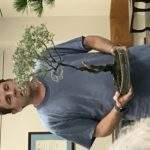Another Hurricane and More Damage

Darn, it seems like déjà vu all over again [1]. Hurricane Nicole was the first November hurricane for me and while it could have been worse it did leave damage in my garden and around my house. The Ian-Nicole one-two punch also caused extensive beach erosion. I hope everyone fared well and didn’t suffer too much damage from the twin hurricanes. The high winds and hard rain can stress trees, so watch how you apply water post storm especially as the trees start to go dormant. When temperate trees lose their leaves, they don’t need as much water.
[1] Credit to Yogi Berra.
Normally November for me means two things – repot Buddhist Pine, Podocarpus sp., and prepare for the Winter Silhouette show in Kannapolis, North Carolina.
Buddhist Pines are a very root sensitive species. They don’t like to undergo much root work. If I collect a Buddhist Pine, I like to put it straight into a bonsai pot so that I can let it rest without having to disturb the roots for several years.
For trees already in bonsai pots, I repot in November as this allows the cut roots to recover through our cool months. When the winter passes the trees experience explosive growth after their long rest. I usually go quite easy on the roots for a repot. By that I mean I will take a root saw and remove a couple of inches off one side of the root pad without removing the tree from the pot. Fresh soil fills the void.
The next year I do the same process to a different side of the pot. This reduces the root pad over a 4-year period. If you need to change the planting angle you can do it but be gentle and don’t make major cuts on the roots.
My soil mix is 1/3 akadama, 1/3 lava and 1/3 pumice. All soil has been sifted and larger particles used on larger trees and smaller on smaller trees. After the work I mix some starter solution and drench the roots with the vitamins contained therein. Don’t trim too much foliage off the top after repotting. Wait for the growth season of late winter.


Interestingly enough I have never seen a Buddhist Pine as a bonsai in Japan, even though every religious shrine seems to have full sized ones growing in the ground.
However, in China and Taiwan, they have great bonsai specimens. Buddhist Pines enjoy great popularity in China as their Feng Shui practice says they are good to lead a guest in a home, and as their common names implies, they have religious connotations. The Buddhist Pine is so popular in China that if you have one in your yard and go on vacation, it might get collected (i.e. stolen) while you are away. An abundance of new Chinese money has actually caused the trees’ prices to escalate well beyond inflation.
To satisfy demand both Chinese landscape nurseries and several Japanese landscape nurseries grow big Podocarpus and then ship them in burlap bags to Chinese buyers. Unscrupulous sellers are denuding the forest of natural Buddhist Pine to meet this crazy Chinese demand. Some thieves take boats to Hong Kong, and then infiltrate the forest areas when they grow native. However, Hong Kong police have stepped up enforcement action. Unfortunately, most poachers have little concern either for the environment or for the trees themselves. If they think they will get caught, they dump the old and ancient trunks in the South China Sea.
Luckily for us, Podocarpus are common landscape trees in Florida and readily available from nurseries or even urban collecting.

As for the Winter Silhouette Show, this is my 7th year going. I had three display ideas – a Scandinavian style shohin display, a Slash Pine infused display, or a Buddhist Pine display themed with Feng Shui.
I eventually decided on the last idea and will be showing one of my large my Buddhist Pines. I will share pictures up return from the show. I find it a very relaxing event with a nice assortment of trees in a beautiful facility. You should go sometime.

Rob Kempinski
Rob is an internationally recognized bonsai artist and author. He enjoys teaching bonsai at all levels and introducing newcomers to the pleasing art of growing miniature trees in a container. Rob has written many articles for bonsai magazines and journals. He has published several books, many on the art of bonsai.

Bonsai Society of Brevard
For more detailed information contact our Brevard based Bonsai club.
The Bonsai Society of Brevard is one of the many clubs within the Bonsai Societies of Florida.
